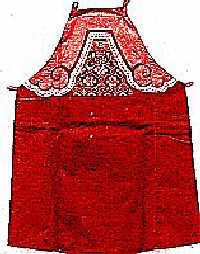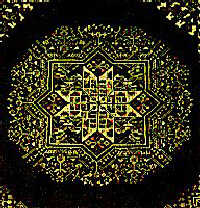 It is feasible that techniques and designs spread from China via India and Egypt to the great civilizations of Greece and Rome and then to the eastern Mediterranean and the Middle East. An alternative school of thought says that the spread of cross-stitched embroidery may have gone in the opposite direction since the first important migration of foreigners into China took place during the Tang Dynasty. Many Persians, Arabs and travelers from Greece and India followed the silk routes into China and eventually settled there. There is evidence that these immigrants influenced the designs of Chinese arts and crafts, particularly textiles. The patterns found on many Chinese textiles are very similar to those found on Persian fabrics.
It is feasible that techniques and designs spread from China via India and Egypt to the great civilizations of Greece and Rome and then to the eastern Mediterranean and the Middle East. An alternative school of thought says that the spread of cross-stitched embroidery may have gone in the opposite direction since the first important migration of foreigners into China took place during the Tang Dynasty. Many Persians, Arabs and travelers from Greece and India followed the silk routes into China and eventually settled there. There is evidence that these immigrants influenced the designs of Chinese arts and crafts, particularly textiles. The patterns found on many Chinese textiles are very similar to those found on Persian fabrics.
The only certainty is that the techniques and designs of cross-stitching spread from such countries throughout the European continent. Crusaders probably brought home embroidered textiles from the Middle Eastern countries after the great crusades. The well-traveled trade and spice caravan routes carried not only merchants and their stock of articles for sale but also itinerant craftsmen, who practiced their craft wherever they went. The spread of cross-stitched designs from their place of origin to many different locations makes it difficult to pinpoint the origin of any one design.
 Designs and stitching have been exchanged between so many different cultures and geographical areas -- via travel, trade and the availability of printed design books -- that many design elements are now common to a number of cultures. Even today, it is fascinating to see the same motifs recur in traditional peasant embroideries from countries as far apart as the Greek Islands, Mexico and Thailand. There are many regional variations of similar cross-stitched shapes, including the eight-pointed star, heart, and flower and bird motifs, as each basic shape is made to fit the fabric grid in a slightly different way.
Designs and stitching have been exchanged between so many different cultures and geographical areas -- via travel, trade and the availability of printed design books -- that many design elements are now common to a number of cultures. Even today, it is fascinating to see the same motifs recur in traditional peasant embroideries from countries as far apart as the Greek Islands, Mexico and Thailand. There are many regional variations of similar cross-stitched shapes, including the eight-pointed star, heart, and flower and bird motifs, as each basic shape is made to fit the fabric grid in a slightly different way.
 Looking after cross-stitched works
Looking after cross-stitched works
Embroidered items, such as tablemats and napkins, which are intended to be used rather than displayed, must be laundered at regular intervals to remain in tiptop condition. If you suspect that the threads may not be colorfast, have the piece dry-cleaned instead of cleaning it yourself. The best way to clean cross-stitched works is to wash them carefully by hand in hot water with a mild, detergent-free cleaning agent. Most specialist fabric shampoos are ideal, but check that they do not contain optical brighteners, which will cause the thread and fabric colors to fade. Rinse thoroughly several times and then roll in a towel and press gently to remove surplus water. Gently ease back into shape and dry away from direct sunlight.
which are intended to be used rather than displayed, must be laundered at regular intervals to remain in tiptop condition. If you suspect that the threads may not be colorfast, have the piece dry-cleaned instead of cleaning it yourself. The best way to clean cross-stitched works is to wash them carefully by hand in hot water with a mild, detergent-free cleaning agent. Most specialist fabric shampoos are ideal, but check that they do not contain optical brighteners, which will cause the thread and fabric colors to fade. Rinse thoroughly several times and then roll in a towel and press gently to remove surplus water. Gently ease back into shape and dry away from direct sunlight.
When using table linen, take immediate measures to correct spills and stains: Mop up the excess liquid withpapertowels or tissues and rinse the fabric under running tepid water. Scrape off spilled foods quickly and then blot with a paper towel before washing in the usual way. For stubborn stains, use a solvent or brand-name stain remover, but be sure to test a small area first; if unsure, seek professional advice. When treating stains, remember that it is better to repeat a mild treatment several times rather than using a harsh solvent that may damage both threads and fabrics.
 Press the embroidery while it is still slightly damp: Pad an ironing board with a couple of old, clean towels, then lay the embroidery on with the wrong side up. Cover with a piece of clean white fabric (a cotton sheet is ideal). Set your iron to a temperature that corresponds to the fabric's composition, for example, the linen setting for linens, slightly cooler for Aida and cotton fabrics, and even lower for even-woven fabrics made from cotton/viscose mixtures. Press lightly, taking care not to flatten the stitches. Old-fashioned laundry starch will give an attractive, crisp finish to table linen. Make sure the iron is not too hot.
Press the embroidery while it is still slightly damp: Pad an ironing board with a couple of old, clean towels, then lay the embroidery on with the wrong side up. Cover with a piece of clean white fabric (a cotton sheet is ideal). Set your iron to a temperature that corresponds to the fabric's composition, for example, the linen setting for linens, slightly cooler for Aida and cotton fabrics, and even lower for even-woven fabrics made from cotton/viscose mixtures. Press lightly, taking care not to flatten the stitches. Old-fashioned laundry starch will give an attractive, crisp finish to table linen. Make sure the iron is not too hot.
